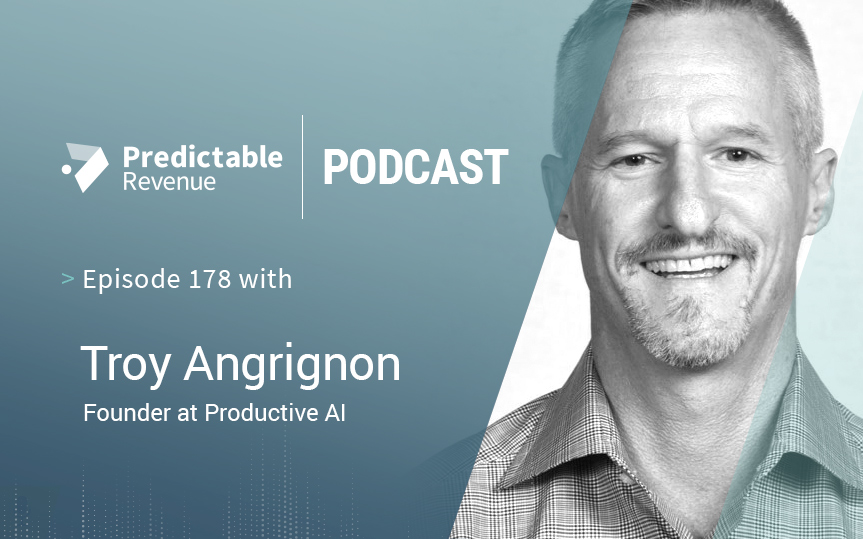How to Get The Attention of Any Decision-Maker to Expand Your Sales Within An Enterprise Account

Troy Angrignon, a recent guest on the Predictable Revenue podcast, has sold into huge companies in every space imaginable, from IT, to state government, to Fortune 100 oil and gas. Over 25 years he has come up with some indisputable tactics on what exactly you need to do to get a meeting with any decision-maker at a large account. Here is his 6 step process for account managers to expand their business within a target account.
1. PRIORITIZING ACCOUNTS
The first thing you should do when you get a setlist of accounts is prioritize them. Start with your highest value existing clients who generate the most recurring revenue for your company. You can determine this by pulling reports from your company’s data to see how much each of the accounts on your list has spent with you over the past 5 years. In all likelihood, 20% of the accounts on your list will have delivered 80% of your company’s revenue.
So, the top 20% of your list become your Tier 1s. You want to keep Tier 1s and keep them happy. Tier 2 is filled with accounts that have done a bit of business with you and now there is the potential to expand. Tier 3s are accounts you’ve engaged with, but you’ve yet to do business with. Tier 4s have never heard of you and never engaged with you. It’s probably the best use of your time to prioritize Tiers 1 and 2.
2. MAPPING THE ACCOUNT
Even if your company has done business with an account before, there’s a lot of institutional knowledge not captured in your CRM. So, find out who at your company has worked with this account before and invite them to a whiteboard session to help you map out each decision-maker on the executive team and the technical team, who your allies are, who’s neutral towards you, and who still needs convincing, their priorities, and your history with them.
3. RESEARCH
Before you even think about asking for 30 minutes of that exec’s time, you need to familiarize yourself with a few things.
- Business: You need to know the basics of business in any industry – accounting and finance, revenue and growth, operations
- Industry: You don’t have to come from a background in the industry you’re selling into, but you do need to put in the time to learn as much about it as you can. What are the different types of companies? Sub-verticals? Know enough about the industry that you can speak intelligently to someone who works solely in that industry
- Customer: You need to know everything about your specific customer type in your specific industry. What are their strategic priorities? What are they working on? What are their priorities? You can find this information in press releases and their annual reports.
Troy is a voracious notetaker. He prefers a good, old-fashioned document or notes app, but you can populate a notes field or several custom fields in your CRM with the information you find.
Either way, once Troy has accumulated all the necessary information he shares it with the whole sales team so everyone has the same situational awareness on the customer, their problems, and their priorities.
4. GETTING THE MEETING
Once you’ve chosen your top accounts, figured out your key players, their challenges and strategic priorities, and you’ve done your research on the industry and company, you’re ready to speak to your target exec. But don’t just cold call them.
Do everything in your power to get a warm introduction from someone at your company who has worked with this account, or from someone within the account who your company has worked with before.
If you’re wondering how to get that warm intro from within the account – it’s all about value. If you’ve positioned yourself as a strategic partner and trusted advisor to your contacts within this account, there will be a give and take.
Offer to share details on the projects the account is currently working on, their strategic priorities, and the history between your two companies to your new target, and you might actually be taking something off your contact’s plate, for which they’d be happy to make the intro.
5. NAILING THE FIRST CALL
When you finally do have your first call with the target decision-maker at your target account, the structure of that call is very important.
Troy has 2 rules: establish value fast and don’t make assumptions. You need to show you’ve done your research in the first 3-5 minutes on the line. Fill them in on your role, the projects you’re working on, the projects those projects are tied to, and how they fall under this decision-maker’s domain. Offer to give them a review of everything that you’ve done with their company historically, and how you fit in with their 5-year plan and strategic priorities. Then ask if they agree with everything you’ve said, or if they have different priorities.
Approaching a call this way proves you are a strategic partner, rather than just another vendor. You have shown you know, in some cases, more than the exec themself might know about the projects and goings-on at their company. You are someone they can work through problems with to come up with solutions.
OPTION: REVERSE-ENGINEER AND SCALE
In one of Troy’s past roles in the cybersecurity space, he wondered if he could reverse engineer this approach and scale it to spark conversations with new accounts. If he started not with the list of target accounts, but rather with the challenge his company could solve, could he send out effective “mass” messaging?
Troy and his team knew that, at that time, ransomware was a critical problem that was growing rapidly, and it was affecting many CISOs at many companies. So Troy and his team started to research the problem, its long and short-term impacts on businesses, what companies were doing about it, and anything else they could find on the matter.
They ended up with a 300-page document which they boiled down to 2 concise and densely-packed pages of content that would be invaluable to any CISO at the time. They segmented the market by title, industry, and geography, and emailed the piece of content to their prospects along with a templatized message.
This was a mass message but was of extremely high value to the prospects. It offered them more information than they already had on a pressing issue they were facing and provided important information on the way their peers were solving the issue.
6. TIME-MANAGEMENT
We’ve established that Troy’s approach is very research-intensive. So how do you juggle all the hours of crawling the web and picking your colleagues’ brains over a target account, with actually reaching out and selling?
Troy maintains that while it sounds like a lot of work, once you’ve done it a few times it goes by quickly. He also suggests that you front-load all the research. As soon as you’ve identified your Tier 1s in that list of accounts, open up their website and every page on that website in dozens of tabs.
Open up Crunchbase and Owler and LinkedIn. Open up your databases and CRM and pull a bunch of reports. Have a 1-2 hour whiteboard session with everybody at your company who knows the account in question to map the account with you. It’s worth it to spend all this time on getting it right when you’re targeting huge accounts where the revenue your company may gain is in the millions.
BONUS: BOOKING A MEETING WITH A SPEAKER DURING A VIRTUAL CONFERENCE
Most of what we’ve covered so far in this article has been geared towards account managers who aren’t doing strictly cold prospecting, but engaging with specific lists of accounts that their company has likely worked with before. But Troy is no stranger to cold outreach. In fact, this one strategy of his yields a 95% response rate.
If a person Troy is hoping to get on a call with is speaking at a virtual conference, you can be sure Troy will be in attendance. He joins the conference apps, the slack communities, and the zoom happy hours. He listens to the talk his prospect gives and takes notes of any comments or questions he has for them.
Then, after their talk, he reaches out to them on the virtual conference system (or slack community – wherever people are hanging out during this particular virtual event). He mentions what he liked about their talk, asks any questions he has, and mentions that he’d like to have a conversation with them on a problem he can solve.
Troy shows that he’s done his research on them and cares about the message they’re trying to get across at the event. Because these prospects are in the flow of the virtual conference, the response rates are exceptionally high.
CONCLUSION
Account managers: picture this. A list of target accounts lands on your desk. Your company has done business with most of them before, so there’s a complete list of all key decision-makers at the account with accurate, up to date contact information, each decision-maker’s specific challenges, and their strategic priorities.
You call them and they immediately recognize your number and think to themselves, “Yes, just what I needed. A conversation to hash out some challenges and find solutions with my trusted advisor.” They give you an hour and a half of their time and you come away having tripled business with this account. Unfortunately, that’s not the reality.
You have to work hard to book a meeting, especially with a difficult to reach executive from a large account. But Troy’s 6 step process will certainly get you a lot closer.
EDITOR’S NOTES:
Similar to Troy’s reverse-engineered and scaled approach, Michel Feaster also starts with a critical problem that is plaguing a particular persona to be the foundation for new software products she wants to build: The Framework For Creating a Product – And a Brand-New Category
More on selling into large accounts: Swimming upstream: how Proposify went from selling self serve deals to working with enterprise clients with CEO Kyle Racki
NO TIME TO READ?
Listen On:
Although there are unique challenges that come with working online, there are also a lot of great benefits. This ebook will show you how to make the most of leading a remote team, from the hiring and onboarding process to virtual coaching tips, team building, and more.



